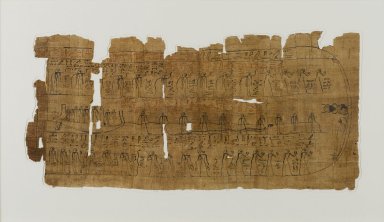
Medium: Papyrus, ink
Geograhical Locations:
Dates:ca. 1075–945 B.C.E.
Dimensions: Sheet: 9 1/2 x 20 in. (24.1 x 50.8 cm) 37.1699Ea, as mounted: 24 1/2 x 13 15/16 x 7/8 in. (62.2 x 35.4 x 2.2 cm)
Collections:
Exhibitions:
Accession Number: 37.1699Ea-c
Image: 37.1699Ea_PS1.jpg,
Catalogue Description: One of two large fragments of a papyrus decorated on one side with vignette illustrating the Twelfth Hour of the "Amduat". Fragment (A): rectangular in shape, which has been pieced together from several fragments. The fragment preserved part of the vignette. The vignette is oblong in outline with a rounded right end and formed by the outstretched arms of the Sun god. The decoration is in four registers. Register A is a line of text the right end of which is written in black ink and the remainder in red ink. In register B there are, at the right end, four male figures standing with their hands up before them. Before each figure is a short label (name ?). Figures and text are drawn in black ink. Behind these four figures are eight standing female figures each of whom has a cobra (in the form of the hieroglyph "d") resting on her shoulder. As was the case with the male figures, each of these figures is identified by a short text. In register C there is a representation of a bark being towed-to the right- by six bearded male figures who face forwards. Before them are three female figures who are also towing the boat but who turn their heads towards the bark. Beneath the feet of the six male figures is a large snake. The front part of the boat, which is here preserved, is high-prowed. Standing on the boat are two small figures behind whom stands a ram-headed god who stands beneath a long snake whose body forms a sort of canopy over him. In register D there are, at the right, six male figures who hole their hands up before them. They are followed by four bearded males each carrying an oar, a serpent standing on the tip of its tail, a double-headed (bird's head) god carrying an oar, a crocodile-headed god holding an oar, and a bearded male figure carrying an oar. There is a text, written in black above all these figures. At the right end are the scarab and figures drawn. Fragment (B): appears to continue the vignette of fragment (A) but the two pieces do no join. The right end of (B) continues the scene represented on (A). On register A there is the end of a text written in red. In register B there are two women with cobras resting upon their shoulders. In C there is the rear part of the boat with three deities standing on the deck. In D there is part of figure holding an oar followed by three female figures who hold "Was"-scepters. In the place marked E in the drawing on card 5 there are the partial remains of two columns of text written in red. F is the remains of a line of text written in black while G is 2 columns of black text. H is a representation of a female figure seated upon two cobras. I is the remains of a column of text written in red while J is a representation of two female (?) figures wearing White Crowns. K is two columns of text written in red. L is a male figure facing left and M is a squatting female figure who is also facing left. O and P are columns of text written in black while Q is a line of text written in red ink. R is a line of text written in black. S is, from right to left, a text written in black followed by two goddesses each of whom is seated upon two cobras. T is a line of text written in red. U is a text written in black. V is some circular object. Many of the figures on fragment (B), such as the crowns and serpent below T, the two figures wearing the White Crowns (J), and the female figures seated upon the cobras (H, and S) appear to belong to representations of the Eleventh Hour of the "Amduat" and it seems probable that the left part of the fragment (B) is decorated with a representation of that hour. Condition: Many gaps and tears. The papyrus is darkened and there is, especially on (B), black incrustation.